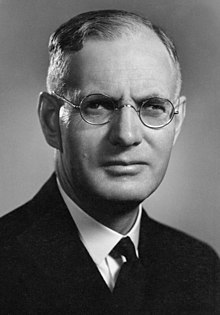
Back John Curtin Afrikaans جون كيرتن Arabic جون كيرتن ARZ Джон Кёрцін Byelorussian John Curtin Czech John Curtin Danish John Curtin German John Curtin Spanish John Curtin Basque جون کارتین Persian
John Curtin | |
|---|---|
 Official portrait, 1942 | |
| 14th Prime Minister of Australia | |
| In office 7 October 1941 – 5 July 1945 | |
| Monarch | George VI |
| Governors‑General | Lord Gowrie The Duke of Gloucester |
| Deputy | Frank Forde |
| Preceded by | Arthur Fadden |
| Succeeded by | Frank Forde |
| Minister for Defence[a] | |
| In office 7 October 1941 – 5 July 1945 | |
| Prime Minister | Himself |
| Preceded by | Robert Menzies |
| Succeeded by | Jack Beasley |
| Leader of the Opposition | |
| In office 1 October 1935 – 7 October 1941 | |
| Prime Minister | Joseph Lyons Earle Page Robert Menzies Arthur Fadden |
| Deputy | Frank Forde |
| Preceded by | James Scullin |
| Succeeded by | Arthur Fadden |
| Leader of the Labor Party | |
| In office 1 October 1935 – 5 July 1945 | |
| Deputy | Frank Forde |
| Preceded by | James Scullin |
| Succeeded by | Ben Chifley |
| Member of the Australian Parliament for Fremantle | |
| In office 15 September 1934 – 5 July 1945 | |
| Preceded by | William Watson |
| Succeeded by | Kim Beazley Sr. |
| In office 17 November 1928 – 19 December 1931 | |
| Preceded by | William Watson |
| Succeeded by | William Watson |
| Personal details | |
| Born | John Joseph Ambrose Curtin 8 January 1885 Creswick, Colony of Victoria |
| Died | 5 July 1945 (aged 60) Canberra, Australia |
| Resting place | Karrakatta Cemetery |
| Political party | Labor |
| Other political affiliations | Victorian Socialist Party |
| Spouse | |
| Relations | Claude Curtin (nephew) |
| Children | 2 |
| Signature | |
| ||
|---|---|---|
Term of government (1941–1945)
Ministries Elections |
||
John Curtin (8 January 1885 – 5 July 1945) was an Australian politician who served as the 14th prime minister of Australia from 1941 until his death in 1945. He held office as the leader of the Australian Labor Party (ALP), having been most notable for leading the country through the majority of World War II, including all but the last few weeks of the war in the Pacific. Curtin's leadership skills and personal character were acclaimed by his political contemporaries and he is frequently ranked as one of Australia's greatest prime ministers and political leaders.[1][2][3][4]
Curtin left school at the age of 13 and became involved in the labour movement in Melbourne. He joined the Labor Party at a young age and was also involved with the Victorian Socialist Party. He became state secretary of the Timberworkers' Union in 1911 and federal president in 1914. Curtin was a leader of the "No" campaign during the 1916 referendum on overseas conscription, and was briefly jailed for refusing to attend a compulsory medical examination. He moved to Perth the following year to become the editor of the Westralian Worker, and later was state president of the Australian Journalists' Association.
After three unsuccessful attempts, Curtin was elected to the House of Representatives at the 1928 federal election, winning the Division of Fremantle. He is the only prime minister to have represented a constituency in Western Australia. He remained loyal to the Labor government during the party split of 1931. He lost his seat in Labor's landslide defeat at the 1931 election, but won it back in 1934. The following year, Curtin was elected party leader in place of James Scullin, defeating Frank Forde by a single vote. The party gained seats at the 1937 and 1940 elections, with the latter resulting in a hung parliament. The ALP eventually formed a minority government in October 1941, when the Fadden government lost a confidence motion.
The Japanese attacks on British Malaya and Pearl Harbor occurred two months after Curtin became prime minister, and Australia entered the war against Japan. Bombing raids on northern Australia soon followed. Curtin led the nation's war effort and made significant decisions about how the war was conducted. He placed Australian forces under the command of the American general Douglas MacArthur, with whom he formed a close relationship, and successfully negotiated the issue of overseas conscription that had split his party during World War I. The ALP won almost two-thirds of the seats in the House of Representatives at the 1943 election, which remains a party record. Curtin died in office in July 1945, after months of ill health attributed to the stresses of the war. Many of his post-war reconstruction plans were implemented by his successor Ben Chifley, who in 1946 led the ALP to consecutive victories for the first time.
Cite error: There are <ref group=lower-alpha> tags or {{efn}} templates on this page, but the references will not show without a {{reflist|group=lower-alpha}} template or {{notelist}} template (see the help page).
- ^ "Prime ministers' rank and file". The Age. 18 December 2004. Archived from the original on 14 November 2012. Retrieved 30 December 2017.
- ^ Strangio, Paul (2 August 2021). "Who were Australia's best prime ministers? We asked the experts". The Conversation. Archived from the original on 16 August 2023. Retrieved 4 August 2021.
- ^ Strangio, Paul (2013). "Evaluating Prime-Ministerial Performance: The Australian Experience". In Strangio, Paul; 't Hart, Paul; Walter, James (eds.). Understanding Prime-Ministerial Performance: Comparative Perspectives. Oxford University Press. ISBN 9780199666423.
- ^ "Ranking Australia's prime ministers". Sydney Morning Herald. 25 June 2010. Archived from the original on 25 October 2018. Retrieved 17 August 2011.
